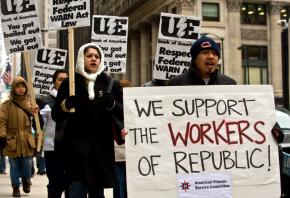Victory at Republic!
reports on the workers' big win in a factory occupation that made headlines across the U.S. and inspired union members and activists everywhere.
WITH A unanimous vote, workers at the Republic Windows & Doors plant in Chicago ended their six-day factory occupation late on December 10 after Bank of America and other lenders agreed to fund about $2 million in severance and vacation pay as well as health insurance.
"Everybody feels great," said a tired but beaming Armando Robles, president of United Electrical, Radio and Machine Workers (UE) Local 1110.
Melvin Maclin, the local's vice president, agreed. "I feel wonderful," he said. "I feel validated as a human being. Everybody is so overjoyed. This is significant because it shows workers everywhere that we do have a voice in this economy. Because we're the backbone of this country. It's not the CEOs. It's the working people."
Pointing, he continued, "See that sign up there? Without us, it would just say 'Republic,' because we make the windows and doors. This shows that you can fight--and that you have to fight."
The settlement was a resounding victory for union members who were told a little more than a week earlier that the factory would be closed in less than three day's time--and that, contrary to federal law, they would get no severance pay.

So to pressure the company to make good on what it owed them, the workers voted to stay put after the plant ceased production on December 5.
By deciding to occupy their factory--a tactic used by labor in the 1930s, but virtually unknown in this country since--the Republic workers sparked a solidarity movement that forced one of the biggest banks in the U.S. to pay two months of wages and health care, even though the bank had no legal obligation to do so.
WHAT BEGAN as a resolute act of some 250 workers quickly became a national symbol of working-class resistance in a crisis-bound economy. Hundreds upon hundreds of union members and officials--not only from Chicago, but around the Midwest--came to the Republic factory to express their solidarity and bring donations of food and badly needed funds.
But support for the Republic struggle went beyond the ranks of organized labor. The fightback crystallized mass anger about the $700 billion bailout of Wall Street. Even though Bank of America--Republic's main creditor--is in line to receive $25 billion in taxpayer money, the bank refused to finance the 60 days' pay due to workers under the federal WARN Act if a plant closes without the two-month notice required under the law.
Democratic politicians, from President-elect Barack Obama down to Chicago aldermen, felt the pressure to declare their support for the struggle.
Press coverage was affected as well. For once, the media not only highlighted the issues in a labor struggle, but also used their resources to investigate the employer. The Chicago Tribune reported that Republic's main owner, Rich Gillman, was involved in the purchase of a nonunion window factory in Iowa to move to. Journalists also uncovered evidence that Bank of America refused repeated requests to extend more credit to Republic, despite its infusion of bailout money.
Thus, when UE decided to make Bank of America the target of a December 10 rally, there was a ready response--about 1,000 people turned out on short notice.
"Since we're down here in the financial district, let's do a little mathematics," said Rev. Gregory Livingston of Rainbow/PUSH. "Bank of America got $25 billion. Citibank got $25 billion. Republic workers got how much? Zero.
"That's why we're here in the financial district. It's where the money is. The people work, and guess whose money is in these banks? Guess whose money is in the market? Guess whose money is in their pockets? It's our money."
But what was noteworthy about the picket wasn't the anger against the banks, but a palpable sense of workers' power. Members of a dozen different unions were on hand, as were student groups, socialists and community groups, all inspired by the Republic workers' bold stand.
Larry Spivack, regional director of AFSCME Council 31, summed up the mood in his speech. "Look around you," he told the crowd, naming the main financial institutions nearby. "Who created all their wealth?" he asked--and was answered by the chant, "We did!" "Who has the power?" "We do!"
Spivack continued: "This is a beginning, like when the Haymarket struggle took place in 1886," a reference to the Chicago martyrs in the struggle for the eight-hour workday. He concluded with a shout, "Power to the workers!"
A few hours later, back at the Republic plant, after workers heard the terms of the agreement and voted, Bob Kingsley, the national director of organization for UE, made a similar point in assessing the victory:
The significance of this struggle for the labor movement is that at a time when millions of American workers are facing greater and greater economic turmoil, and with it more and more instances of unfairness, there needed to be a clear symbol of resistance.
What the workers at Republic are is the face of that resistance. They personify the challenge that the working class faces in today's economy, but they also symbolize the hope that if we, as workers, stick together, if we fight together, and if we're willing to push the limits, we can achieve incredible things. And their victory comes at a time when the labor movement needs it.


